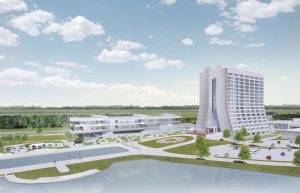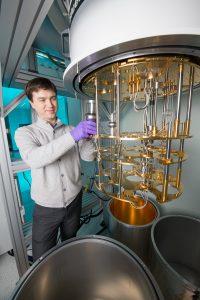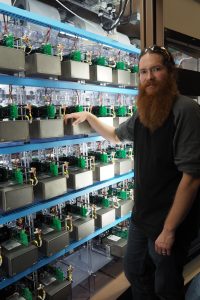
The new engineering center will be built to the east of Wilson Hall. Conceptual design by Holabird & Root
Plans to build a focal point for Fermilab engineering called the Integrated Engineering Research Center, at the Department of Energy’s Fermi National Accelerator Laboratory have been evolving for the past six years. This spring the project received the remainder of Congressional funding for design and initial construction funding. Fermilab subcontracted with an architectural firm at the beginning of July to begin transforming the building from a concept into a final design.
The new center, which many hope will be a beacon to attract some of the world’s best and brightest engineers, will be a major addition to the Fermilab site and will expand the complex of buildings surrounding Wilson Hall — a 16-story high-rise and Fermilab’s main office building that was built nearly five decades ago.
“What makes a national laboratory so valuable to the nation isn’t just the scientists,” said Tim Meyer, Fermilab chief operating officer. “It’s the combination of scientists, engineers, technicians, and facilities. This center will be a testament to that synergy. It will create a space for all to join forces and work on the future of particle physics.”
To begin the architectural design process, the project team has been communicating with engineers and scientists who will be setting up shop in the new building to determine what sort of space and facilities they will need. The goal is to design the building with an eye on adaptability. Rather than creating many custom spaces, the team is developing five or six different types of spaces that will support a variety of scientific requirements. Once space types are established, the designers and architects will turn their attention to fitting these spaces together and creating the shape and look of the building. A main requirement of the design of IERC is to respect and honor the heritage and vision of Wilson Hall and the Fermilab campus.
The new building will be located to the northeast of Wilson Hall and will connect to Wilson Hall to allow for fluid collaboration. A new parking lot will accommodate existing and future parking requirements. Construction is set to start next summer and will likely be completed by the end of 2021. A detailed schedule will be established once the project receives the final go-ahead by the Department of Energy next year.
The center will host existing and international teams of engineers, technicians, and scientists who will further develop Fermilab’s neutrino program and support Fermilab’s upgrade projects for the Large Hadron Collider at CERN. It will also provide better research and collaborative spaces for research initiatives such as liquid-argon engineering, the design of electronics and ASIC development, and quantum science programs.
“The building will consolidate and centralize people who are currently scattered across the Fermilab site to the central campus area,” said Kate Sienkiewicz, project manager for the IERC. “The idea is to connect the engineers in the IERC and the scientists and projects teams in Wilson Hall to enable collaboration in solving technical challenges. It will provide additional multifunctional space for new initiatives.”
The project, Meyer said, “indicates a level of support, confidence and enthusiasm between the Department of Energy, Congress and Fermilab, symbolizing the injection of energy and resources into the lab’s future.”
After celebrating 50 years of science and discovery last year, the Fermilab and broader particle physics communities are ready to tackle another half-century of innovation.
“Wilson Hall is iconic, it’s been here for decades and signifies all the great work that we’ve done up to this point,” Sienkiewicz said. “This new building is in some ways a physical representation of the next 50 years of Fermilab. We look forward to a bright future.”

Alex Romanenko prepares to cool superconducting accelerator cavities, the silver-colored objects, to convert it into a quantum device. Photo: Reidar Hahn
Some of the most exciting advances in modern scientific research are in the field of quantum science and technology. Among them is quantum computing, a novel data-crunching technique that could revolutionize everything from biochemistry to codebreaking.
The Department of Energy’s Fermilab is positioning itself to be a forerunner in the hugely exciting field, with a new lab on site dedicated to its research and development. Favorable to Fermilab is its expertise with particle accelerator technology, which scientists are now adapting to produce game-changing quantum systems. Specifically, the superconducting radio-frequency (SRF) technology developed at the lab could help push quantum computing into a new realm.
As part of the DOE Office of Science Quantum Information Science-Enabled Discovery (QuantISED) program, a consortium of three institutions under the leadership of Fermilab scientist Alexander Romanenko has been awarded $3.9 million over two years to further SRF technology for quantum science, potentially boosting the processing speed and storage capacity of quantum devices, including quantum computers and sensors.
Beyond binary
The device you’re reading this on right now is based, at the lowest levels, on binary code – 1s and 0s. Each 1 or 0 is called a bit, and this has been the basis for all computing, right from the very first prototypes in the early 20th century. But quantum computing works differently, by exploiting strange effects that arise at the subatomic level, such that a quantum bit – or qubit – can exist as a combination of both 1 and 0.
A big stumbling block with current attempts at quantum systems is keeping this fragile superposition of 1 and 0 stable long enough to make it useful. Leading groups have managed to maintain superpositions in quantum computers for only a few milliseconds, which severely limits the potential applications of the technology. Fermilab scientists, along with collaborators at the National Institute of Standards and Technology and the University of Wisconsin – Madison, are aiming to make a big improvement on that, keeping the systems stable much longer, up to a few seconds at a time.
“The longer this stability time, the more you can do with a quantum computer. If it’s very short, you can do nothing,” said Romanenko, head of SRF technology at Fermilab. “We’re aiming to stabilize it for substantially longer than the current best. That’s the big impact we’re after.”
Home advantage
With 50 years of experience operating particle accelerators, Fermilab is home to some of the world’s leading experts in accelerating technologies, including structures called resonating cavities that use extremely low-temperature SRF technology to boost particles as they pass through them.
“Here, we really have among the best experts worldwide in different areas all together, so we are the place where integration can occur. That’s the exciting thing,” said Anna Grassellino, Fermilab scientist and deputy head of the lab’s Applied Physics and Superconducting Technology Division.
By lowering the energy of its electric and magnetic fields and operating it at near absolute zero temperatures — thousandths of a Kelvin — an accelerating cavity can be converted into a quantum device.
A special computer chip – essentially a tiny electrical circuit – is placed inside the cavity. The circuit is made of a special material that, at extremely cool temperatures, allows pairs of electrons to flow freely around — to superconduct.
The surrounding cavity gives the chip a pulse of photons, transferring a tiny amount of energy to the electrons in the chip’s circuit. But because this all takes place in the strange quantum world, the electrons become both energized and not at the same time – a superposition. Together, the chip and the cavity represent a single qubit.
A further pulse then allows the scientists to gain information from the chip.
If some of the energy of the pulse is absorbed by the cavity walls, the quantum superposition collapses, and the quantum computer becomes useless, which is one of the major problems faced by quantum groups. One of the key reasons Fermilab may be able to produce quantum systems that last longer than any other is the specialized manufacture of the cavity itself, which reduces pulse absorption and was developed at the laboratory.
“Fermilab is one of the world leaders in SRF technology,” said Fermilab Deputy Director Joe Lykken. “That’s why our research has delved into this quantum world — because we know we can make an impact based on our unique strengths in these and other areas.”
A quantum future
Quantum computers are not likely to replace current technology any time soon. The techniques are not directly comparable, and while a quantum approach is better suited for carrying out certain tasks, classical computing still maintains advantages.
“Quantum computing is different, not always better,” Romanenko explained.
The tasks that quantum computing could excel at include simulating the quantum systems that underlie high-energy physics. With its superposition advantage, a quantum computer may be able to carry out many more calculations in a given time than a classical system, rendering complex codes breakable and protein-folding far easier to model.
The quantum technology under development at Fermilab even has potential applications outside of computing. Fermilab is developing quantum sensors, such as the high-quality cavities, to detect candidate dark matter particles called dark photons.
These future possibilities may not even be too far off. The team behind the quantum effort are optimistic about the timescale.
“If all goes well, there should be the world’s best superconducting qubit here in just a few months,” Romanenko said.

Technician Nick Gurley was one of the Fermilab team who helped install the Marx modulators for the Fermilab linear accelerator. Photo: Dan Munger
Take a walk along the hall that houses Fermilab’s linear accelerator, and you’ll see tall sets of brightly lit shelves that resemble fancy vending machines. But instead of snacks and beverages, they hold boxy structures that resemble gleaming car batteries. Arranged in neat columns and rows, these cells — known as Marx cells and installed during the last 36 months — have rejuvenated the aging Fermilab linear accelerator, or Fermilab Linac, and help guarantee its exceptional performance for the decade to come.
The installation of five new Marx modulators — each comprising 54 Marx cells — marks the conclusion of a five-year-long project to modernize critical components of the Linac. They replace equipment that had helped power accelerator components since the late 1960s.
“We needed a long-term replacement,” said Fermilab engineer Howie Pfeffer, who began designing the lab’s Marx modulator system in 2013. “We did a lot of modeling and experiments to see if the Marx structure would work. It wasn’t obvious that it would. And we determined that, yeah, we can do it. Along the way we built a number of circuits with smaller numbers of cells before committing to the full 54-cell modulators. Each circuit led us to important changes in the next.”
Most of the power that is fed to an accelerator is used to propel particles. The job of the modulator is to regulate those pulses of power — to shape them in a way that helps kick the particle beam forward at just the right time and right energies.
At Fermilab, the Marx modulators shape the pulses from a 5-million-watt amplifier, and the amplifier’s modulated power is used to accelerate protons in the Fermilab Linac. The specially formed waves propel the proton beam at a pulse rate of 15 times per second.
“The beam energy has to be exact, and most of the task of power regulation is to make sure that, as the particle beams accelerate through the Linac, they settle quickly to within one 10th of one percent of the accuracy level we want,” said Bill Pellico, leader of the Fermilab Proton Improvement Project, under which the Marx modulators were design and installed.
Capitalizing on the beam-tuning flexibility of the Marx modulators, Pfeffer and his engineering team perfectly filled the pulse prescription — a superfast, 350-microsecond pulse with a special shape specifically for injecting beam into the Linac. They also designed the modulators to make real-time corrections during the pulse, ensuring its shape would meet the accelerator’s stringent requirements. These machine learning capabilities enable the modulators to use past beam performance in improving pulse generation.
“This may be the first high-power Marx modulator with real-time pulse shaping feedback,” Pellico said.
The new modulators have improved regulation of the beam energy and also resulted in a nearly 50 percent savings in power over the older power-hungry modulators.
Marx modulators replace technology once common in analog radios and televisions — vacuum tube systems — with solid-state technology. Industry began using Marx modulators in the 1990s. Scientists, engineers and technicians have since developed a number of Marx modulators for particle accelerators, taking advantage of their efficient power use and better beam regulation.
“A lot of the old tubes in our accelerator had become obsolete. We couldn’t buy some of that stuff anymore,” Pellico said. “But now, we have not only a modern system, but also one where you can turn various cells on or off to modulate the power as desired. The design will have lots of applications in powering future particle accelerators — not just at Fermilab, but at other labs and facilities, too.”
The new, easy-to-maintain system enables the lab to generate easy-to-control particle beams, just one part of Fermilab’s effort to modernize its accelerator complex.
“Fermilab’s science program entirely depends on this working,” Pfeffer said. “It was a big responsibility. If we hadn’t gotten this work done, there’s no beam anywhere. So it feels great to see the Marx modulators completely installed and running. And thanks to our people who put it together, it’s the most beautiful circuit I’ve ever seen.”
The Proton Improvement Project is supported by the U.S. Department of Energy Office of Science.
